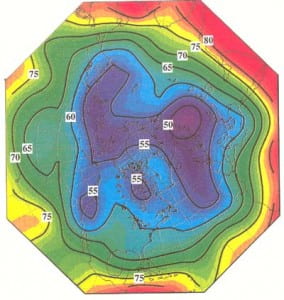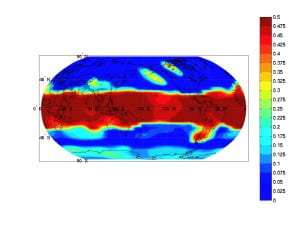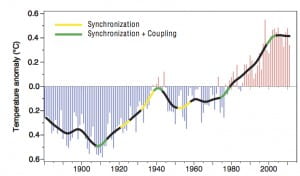The Atmosphere in some respects acts quite randomly. However, this “randomness” obeys certain laws. This figure shows the spatial distribution of a random walk scaling exponent for the Northern Hemisphere 500 mb height field. Contoured values greater then 50 indicate the tendency for anomalies to be persistent independent of the time scale
Total number of links (connections) at each geographic location. The uniformity observed in the tropics indicates that each node possesses the same number of connections. This is not the case in the extratropics where certain nodes possess more links than the rest. For details on how this figure was produced please read “What do networks have to do with climate?”
Summary of synchronization events, coupling between the modes during these events, and climate shifts
2023-
2020-
Climate: a dynamical system with mismatched space and time domains
Lorenz-63 Model as a Metaphor for Transient Complexity in Climate
On the interconnections among major climate modes and their common driving factors
Insights on Streamflow Predictability Across Scales Using Horizontal Visibility Graph Based Networks
On Time Scales of Intrinsic Oscillations in the Climate System
Supplementary material for “On Time Scales of Intrinsic Oscillations in the Climate System”
On the cause-and-effect relations between aerosols, water vapor, and clouds over East Asia
2016-2019
Time scales of the European surface air temperature variability: The role of the 7–8 year cycle
On the min–max estimation of mean daily
temperatures
On the Range of Frequencies of Intrinsic Climate Oscillations
Randomness: a property of the mathematical and physical systems
Transient behavior in the Lorenz model
Synchronization and causality across time scales in El Ni~no Southern Oscillation
Synchronization and causality across time scales in El Niño Southern Oscillation
Model falsifiability and climate slow modes
The Little Boy: El Niño and natural climate change
2010-2015
Teleconnections in the Atmosphere and Oceans
Climate change and the demise of Minoan civilization
What Do Networks Have to Do with Climate?
Atlantic Multidecadal Oscillation and Northern Hemisphere’s climate variability
Community Structure and Dynamics in Climate Networks
Climate Subsystems Pacemakers of Decadal Climate Variability
Climate Mode Covariability and Climate Shifts
Directional influences on global temperature prediction
Climate Subsystems: Pacemakers of Decadal Climate Variability
Review On the origins of decadal climate variability a network perspective
Climate and Landscape Factors Associated with Buruli Ulcer Incidence in Victoria Australia
A climate model intercomparison at the dynamics level
Supplementary Material
A climate model intercomparison at the dynamics level
Geoengineering carries unknown consequences
Indications of a climate effect on Mediterranean fisheries
Two contrasting views of multidecadal climate variability in the twentieth century
Robustness of causal effects of galactic cosmic rays on interannual variation in global temperature
Why Geoengineering and Climate Don’t Go Together
Comment on “Atlantic and Pacific Multidecadal Oscillations and Northern Hemisphere Temperatures
2006-2009
Estimated return periods for Hurricane Katrina
What do networks have to do with climate
High-Frequency Variability in Hurricane Power Dissipation and Its Relationship to Global Temperature
Twenty Years of Nonlinear Dynamics in Geosciences
A new dynamical mechanism for major climate shifts
A new dynamical mechanism for major climate shifts-2
A new dynamical mechanism for major climate shifts
A Network Analysis of U.S. Hurricanes
Anti-persistence in the global temperature anomaly field
Anti-persistence in the global temperature anomaly field-2
Reconstructing dynamics from observables The issue of the delay parameter revisited
Reducing Forecast Uncertainty to Understand Atmospheric Flow Transitions
On the Role of Atmoshperic Teleconnections in Climate
Topology and Predictability of ElNino and La Nina Networks
Topology and Predictability of El Nino and La Nina Networks-2
On the variability of ENSO at millennial timescales
Long-term natural variability and 20th century climate change
Has the climate recently shifted?
Long-term natural variability and 20th century climate change Supporting Information
The pacemaker of major climate shifts
Dynamical changes in the ENSO system in the last 11,000 years
2000-2005
Information Transfer and Home Field Advantage
A characteristic timescale in dollar-yen exchange rates
The impact of nonlinear dynamics in the atmospheric sciences
Probing the linearity and nonlinearity in the transitions of the atmospheric circulation
Linguistic Features in Eukaryotic Genomes
Probing the linearity and nonlinearity in DNA sequences
The Problem of Extracting Precipitation Information in the Tropics from the UWMCOADS Data
On the relation between ENSO and global climate change
The architecture of the climate network
A Small-World Network Hypothesis for Memory and Dreams
Is Global Warming Injecting Randomness Into the Climate System
Exploring nonlinearity to identify genes and intergenic regions in genomes
Unfolding the relation between global temperature and ENSO
A Method to Improve Prediction of Atmospheric Flow Transitions
1996-1999
Dynamical Systems as Models for Physical Processes
Wavelet analysis of DNAsequences
Mapping the channels of communication between the tropics and higher latitudes in the atmosphere
Wide spread increases in low-frequency variability of precipitation over the past century
Hydrological applications of satellite data 1.Rain fall estimation
Hydrological applications of satellite data 2.Flow simulation and soil water estimates
Zipfs Law and the Structure and Evolution of Languages
Simplicity and Complexity in Gene Evolution
Global temperature as a regulator of climate predictability
On the existence of scaling in DNA sequences
Multi-Year Prediction Model of North Atlantic Hurricane Activity
A characteristic timescale in the global temperature record
Long-Range Correlations in the Extratropical Atmospheric Circulation Origins and Implications
The Autocorrelation Function and Human Influences on Climate
1990-1995
Multiple Attractors Fractal Basins and Longterm Climate Dynamics
Comments on Dimension Analysis of Climate Data
Mulitple fractal dimensions in snow
Comparisons of Observed Northern Hemisphere Surface Air Temperature Records
Sensitivity of the Global Climate System to Initial Conditions
Periodicity in DNA Coding Sequences Implication in Gene Evolution
The effect of truncation and round-off on computer simulated chaotic trajectories
Dobidecadal oscillations exist in the global temperature record
Nonlinear Prediction Chaos and Noise
Evidence for Strange attractor structures in space plasmas
Nonlinear prediction as a way of distinguishing chaos from random fractal sequences
Complexity and Predictability of Hourly Precipitation
Nonlinear dynamics established in the ENSO
Empirically derived climate predictability over the extratropical northern hemisphere
Searching for determinism in observed data a review of the issues involved
An Investigation of the Ability of Nonlinear Methods to Infer Dynamics from Observables
Exploiting Geometric Signatures to Accurately Determine Properties of Attractors
Assessing the ability of the Koppen system to delinate the general world pattern of climates
Structure and Properties of the Attractor of a Marine Dynamical System
Testing for Scaling in Natural Forms and Observables
1986-1989
Minimum Detectable Pollution Levels From Satellite Imagery
Counting and Multiple Elliptical Dimensions in Rain
Determining Rain fall Intensity and Type from GOES Imagery in the Midlatitudes
Fractals-A New Look at Biological Shape and Patterning
A Method for Inferring Aerosol Properties From Satellite Data Over Forested Terrain
Some probabilistic aspects of fractal growth
Fractal Characterization and Simulation of Lightning
The weather attractor over very short timescales
Single Thresholding and Rain Area Delineation from Satellite Imagery
Chaos Strange Attractors and Weather
Chaos Principles and Implication in Biology
Chaos and Unpredictability of Weather
On the dynamics of a forced reaction-diffusion model for biological pattern formation
Testing the Global Warming Hypothesis
A Shore-Parallel Cloud Bandover Lake Michigan
1980-1985
An Evaluation of Extrapolation Techniques for the Short-Term Prediction of Rain Amounts
On the Separability of Various Classes from the GOES Visible and Infrared Data
Comments on Physical Interpretation of Results from the HIPLEX-1 Experiment
On a New Approach for Instantaneous Rain Area Delineation in the Midlatitudes Using GOES Data


